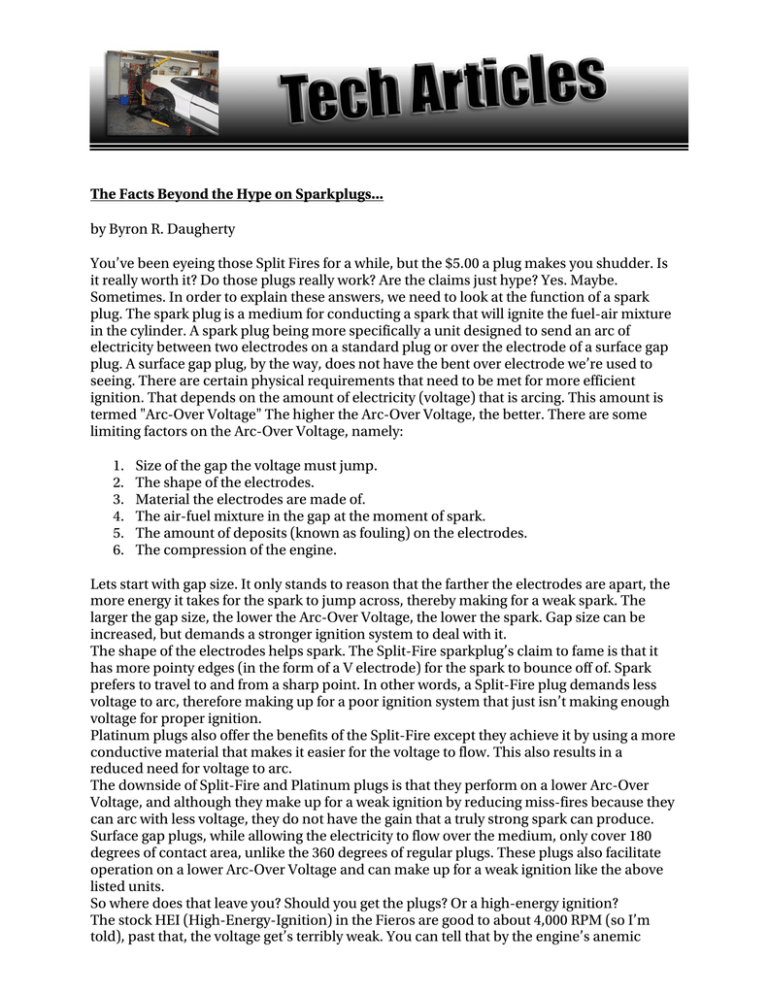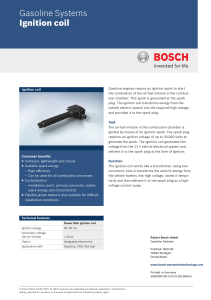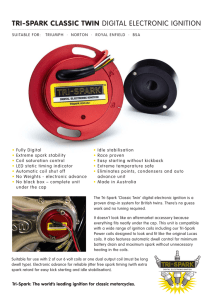The Facts Beyond the Hype on Sparkplugs... by Byron R. Daugherty
advertisement

The Facts Beyond the Hype on Sparkplugs... by Byron R. Daugherty You’ve been eyeing those Split Fires for a while, but the $5.00 a plug makes you shudder. Is it really worth it? Do those plugs really work? Are the claims just hype? Yes. Maybe. Sometimes. In order to explain these answers, we need to look at the function of a spark plug. The spark plug is a medium for conducting a spark that will ignite the fuel-air mixture in the cylinder. A spark plug being more specifically a unit designed to send an arc of electricity between two electrodes on a standard plug or over the electrode of a surface gap plug. A surface gap plug, by the way, does not have the bent over electrode we’re used to seeing. There are certain physical requirements that need to be met for more efficient ignition. That depends on the amount of electricity (voltage) that is arcing. This amount is termed "Arc-Over Voltage" The higher the Arc-Over Voltage, the better. There are some limiting factors on the Arc-Over Voltage, namely: 1. 2. 3. 4. 5. 6. Size of the gap the voltage must jump. The shape of the electrodes. Material the electrodes are made of. The air-fuel mixture in the gap at the moment of spark. The amount of deposits (known as fouling) on the electrodes. The compression of the engine. Lets start with gap size. It only stands to reason that the farther the electrodes are apart, the more energy it takes for the spark to jump across, thereby making for a weak spark. The larger the gap size, the lower the Arc-Over Voltage, the lower the spark. Gap size can be increased, but demands a stronger ignition system to deal with it. The shape of the electrodes helps spark. The Split-Fire sparkplug’s claim to fame is that it has more pointy edges (in the form of a V electrode) for the spark to bounce off of. Spark prefers to travel to and from a sharp point. In other words, a Split-Fire plug demands less voltage to arc, therefore making up for a poor ignition system that just isn’t making enough voltage for proper ignition. Platinum plugs also offer the benefits of the Split-Fire except they achieve it by using a more conductive material that makes it easier for the voltage to flow. This also results in a reduced need for voltage to arc. The downside of Split-Fire and Platinum plugs is that they perform on a lower Arc-Over Voltage, and although they make up for a weak ignition by reducing miss-fires because they can arc with less voltage, they do not have the gain that a truly strong spark can produce. Surface gap plugs, while allowing the electricity to flow over the medium, only cover 180 degrees of contact area, unlike the 360 degrees of regular plugs. These plugs also facilitate operation on a lower Arc-Over Voltage and can make up for a weak ignition like the above listed units. So where does that leave you? Should you get the plugs? Or a high-energy ignition? The stock HEI (High-Energy-Ignition) in the Fieros are good to about 4,000 RPM (so I’m told), past that, the voltage get’s terribly weak. You can tell that by the engine’s anemic feeling above 5,000 RPM. Will specialty plugs work for you? Most likely yes. On your stock ignition, they will decrease miss-fires and therefor increase horsepower (your engine is producing power more often) and better fuel mileage. What about an aftermarket ignition system? Can I throw in an MSD Ignition with Split-Fires to really see a jump? Maybe. Jacob’s Electronics, makers of the Energy Team, Omni-Pak, and Ultra Team have done extensive testing and have concluded thusly, there is no benefit over steel plugs when you have an adequate ignition system (read not stock), UNLESS... Unless you use the lower Arc-Over Voltage requirements of the specialty plugs with the increased ignition system to use a larger gap! Read that again. Larger than stock gap = specialty plugs + aftermarket ignition system. At standard gap, the specialty plugs can not put out the peak spark power that old fashioned steel does with the increased power from the MSD or Ultra Team ignitions. In order to see this more clearly, refer to the Horsepower and Fuel Mileage charts at the bottom. Jacobs Electronics tested these plugs, and their ignition system, on a 4.1 liter GM V6 that was slightly modified. The fuel mileage was averaged per round trip from Los Angelos to Barstow California. Bottom Line: If you want a little better performance from your stock Fiero, or you want to race it but want to stay in stock class, the specialty plugs are definitely worth a try. If your more serious about racing, however, the high-power ignition system with steel plugs is the way for you. Horse Power Steel Platinum Split-Fire Surf.Gap Stock .045" 168 171 171 172.5 Stock .067" 154 161 162 N/A Ultra .045" 180.5 178.5 178.5 179 Ultra .067" 186 184 N/A 185 Fuel Mileage Steel Platinum Split-Fire Surf.Gap Stock .045" 16.4 17.3 17.2 17.3 Stock .067" 16.8 16.7 16.8 N/A Ultra .045" 18.6 18.4 18.4 18.5 Ultra .067" 19 18.7 N/A 18.8 References: Thanks to the following for excellent information on this subject: Grassroots Motorsports Magazine 425 Parque Dr., Ormond Beach, FL 32174; Jacobs Electronics, 500 N. Baird St., Midland, TX 79701; MSD Ignition (Autotronic Controls Corp.), 1490 Henry Brennan Dr., El Paso, TX 79936.




